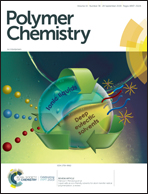Sequential and one-pot post-polymerization modification reactions of thiolactone-containing polymer brushes†
Abstract
Thiolactone chemistry has garnered significant attention as a powerful post-polymerization modification (PPM) route to mutlifunctional polymeric materials. Here, we apply this versatile chemistry to the fabrication of ultrathin, multifunctional polymer surfaces via aminolysis and thiol-mediated double modifications of thiolactone-containing polymer brushes. Polymer brush surfaces were synthesized via microwave-assisted surface-initiated polymerization of DL-homocysteine thiolactone acrylamide. Aminolysis and thiol-Michael double modifications of the thiolactone-functional brush were explored using both sequential and one-pot reactions with bromobenzyl amine and 1H,1H-perfluoro-N-decyl acrylate. X-ray photoelectron spectroscopy and argon gas cluster ion sputter depth profiling enabled quantitative comparison of the sequential and one-pot PPM routes with regard to conversion and spatial distribution of functional groups immobilized throughout thickness of the brush. While one-pot conditions proved to be more effective in immobilizing the amine and acrylate within the brush, the sequential reaction enabled the fabrication of multifunctional, micropatterned brush surfaces using reactive microcontact printing.



 Please wait while we load your content...
Please wait while we load your content...
